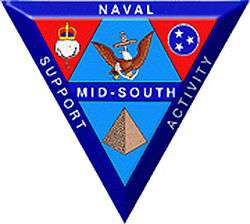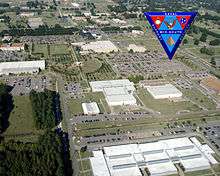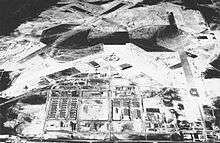Naval Support Activity Mid-South
Naval Support Activity Mid-South (NSA Mid-South, NAVSUPPACT Mid-South, NSAMS), in Millington, Tennessee, is a base of the United States Navy. A part of the Navy Region Southeast and the Navy Installations Command, NSA Mid-South serves as the Navy’s Human Resources Center of Excellence. The base is host to several commands and other military tenants: Navy Personnel Command, Navy Recruiting Command, the Navy Manpower Analysis Center, a Marine reserve Company - Bridge Company C (6th ESB, 4th MLG) and the US Army Corps of Engineers Finance Center. More than 7,500 military, civilian, and contract personnel are assigned/work on base.[1]
| Naval Support Activity Mid-South Park Field | |
|---|---|
| Millington, Tennessee | |
 NSA Mid-South insignia | |
 Naval Support Activity Mid-South | |
| Coordinates | 35°20′05″N 089°52′09″W |
| Type | Military base |
| Site information | |
| Controlled by | United States Navy |
| Site history | |
| Built | 1917 |
| In use | 1917 - present |
| Battles/wars | World War I World War II |
| Garrison information | |
| Current commander | CAPT Scott Wathen |
Initially established as Park Field, it was one of thirty-two Air Service training camps established after the United States entry into World War I in April 1917.[2]
The Naval Support Activity has over 7,500 enlisted and officer personnel, civilians, and full-time contract personnel, who provide all essential logistic and operational support to the commands and activities on board. As the base has evolved and changed, so has its impact on the area. It plays an important part in the community and is one of the largest single employers in the state of Tennessee.[3]
Major commands aboard NSA Mid-South

Of the more than 30 tenant commands that are located aboard Naval Support Activity Mid-South, these are some of the major commands:
- Navy Personnel Command
- Navy Recruiting Command
- Navy Manpower Analysis Center
- Navy Personnel Research, Studies, and Technology
- Bridge Company C, 6th ESB, 4th Marine Logistics Group, Marine Forces Reserve
- U.S. Army Corps of Engineers Finance Center
Community involvement
Throughout the year, NSA Mid-South partners with the Millington and Memphis communities to put on several projects:
- Flag City Freedom Celebration - the annual Fourth of July fireworks display, seeing more than 40,000 visitors to NSA Mid-South's Navy Lake recreational facility.
- National Night Out - a community-police awareness-raising event held the first Tuesday of August. NSA Mid-South's NNO event is one of the largest nationwide.
- Leadership Millington - a leadership program sponsored by the Millington Chamber of Commerce, which includes a day touring NSA Mid-South.
Navy Ten Nautical Miler
Beginning in 2010, Naval Support Activity Mid-South is sponsoring the Navy Ten Nautical Miler, the first and only race measured in nautical miles instead of statute miles. The world-class foot race, intended to take the place of the Navy’s previous premiere race, the Blue Angels Marathon, attracts runners from all over the world.
History
Initially known as Park Field, the facility was established as a World War I training base in 1917. It was named after 1st Lieutenant Joseph D. Park, who was killed on 9 May 1913 when a military biplane, which he was flying plunged its nose into a gulley, turned a somersault and crashed against a tree, at Olive, California, thirty-nine miles southeast of Los Angeles. The aviator fell only fifteen feet, but the radiator crushed his head, and then fell upon his body.[4]
World War I
This site was originally established by the Army Signal Corps which managed Army aviation in its early days in May, 1917 after the United States entered World War I. The Department of War sent a cadre of officers to the Memphis area to survey sites for an aviation school. The group decided on a location in the Millington area, about 16 miles northeast of Memphis. An agreement to lease the land for the Army was concluded, and the construction of some 50 buildings began.[5]
Park Field covered of over 700 acres and could accommodate up to 1,000 personnel. Dozens of wooden buildings served as headquarters, maintenance, and officers’ quarters. Enlisted men had to bivouac in tents. The first unit stationed there was the 160th Aero Squadron, which was transferred from Kelly Field, Texas in November, 1917. However, a few U.S. Army Air Service aircraft arrived with the 160th, Most of the Curtiss JN-4 Jennys to be used for flight training were shipped in wooden crates by railcar.[5]
Park Field served as a base for flight training for the United States Army Air Service. In 1917, flight training occurred in two phases: primary and advanced. Primary training took eight weeks and consisted of pilots learning basic flight skills under dual and solo instruction with a student capacity of 300. After completion of their primary training, flight cadets were then transferred to another base for advanced training.[5]
Training units assigned to Park Field were:[6]
|
|
By February 1918, flight operations were in full swing, but with the sudden end of World War I in November 1918, the future operational status of Park Field was unknown. Cadets in flight training on 11 November 1918 were allowed to complete their training, however no new cadets were assigned to the base. Also the separate training squadrons were consolidated into a single Flying School detachment in December, as many of the personnel assigned were being demobilized. Finally, flight training activities ceased in July, 1919.[5][6]
Inter-war years
In March 1920 the War department officially purchased Park Field, and a small caretaker unit was assigned to the facility for administrative reasons. At that time the airfield began pioneering airmail routes throughout Tennessee and the surrounding states. However, the airfield continued to decline until it was little more than a storage area for aircraft and parts. By 1921, the decision had been made to phase down all activities at the base in accordance with sharply reduced military budgets. and the War Department had ordered the small caretaker force at Park Field to dismantle all remaining structures and to sell them as surplus. The field was closed and abandoned in January, 1922.[5]
Ironically, the Stock Market Crash of 1929 breathed new life into Park Field. During the 1930s the field served as a transient camp for unemployed workers. In 1937 the Resettlement Administration (later the Farm Security Administration) took over the land and developed model farms used to demonstrate what could be achieved with correctly managed land. Park Field remained under this agency's jurisdiction until the outbreak of World War II.
World War II

Just as the onset of World War I had given Park Field its birth in 1917, the declaration of war on December 8, 1941, had similar results, heralding the arrival of naval aviation to the Memphis area. In February 1942, the Navy Shore Station Development Board recommended approval of a reserve aviation base on the former site of Park Field. On September 15, 1942, the Naval Reserve Aviation Base was officially commissioned on the south side of the station.
On January 1, 1943, the Naval Reserve Aviation Base was renamed Naval Air Station Memphis. During the war, Naval Air Station Memphis was a primary flight training center for aviators. It had a training capacity of about 600 flight cadets, and could support up to 10,000 cadets for ground crew training. The facility was expanded to about 3,500 acres in size, and supported sixteen outlying fields (OLF) for training and emergency landings in the area.[7] In 1943, the training facility was designated as the Naval Air Technical Training Center (NATT).[8]
Cold War
As part of the consolidation of facilities after the war, HQ NATT was transferred to NASM in 1946 and all the operations of the command were consolidated there in 1947.[8] In April 1949, the base's functions completely changed, and a new Naval Air Station was established, different in both scope and function.
The new NAS assumed logistic support for all the commands at Navy Memphis, except the Naval Hospital. The boundaries included all Navy property on both sides of the Millington-Arlington Road (Navy Road). NAS Memphis continued its support and logistics role for some 50 years. The faculty was made a permanent Naval Installation during the Korean War, and during the 1950s, it supported approximately 13,000 uniformed and civilian Naval personnel.[8] During the Vietnam War, 23,000 trainees were assigned to NASM, which continued to provide service to the Navy into the 1990s.[8]
Modern era
The 1993 Base Realignment and Closure Commission directed the realignment of Naval Air Station Memphis. The largest segments of this BRAC action were as follows:
- Disestablishment of Naval Air Technical Training Center (NATTC) Memphis and the establishment of a new NATTC Pensacola as NAS Pensacola, Florida, on the grounds of the former Naval Aviation Depot (NADEP) Pensacola, the disestablishment of NADEP Pensacola also being BRAC-directed
- Relocation of all USN and USMC enlisted aviation "A" schools and "C" schools at NATTC Memphis to NATTC Pensacola
- Disestablishment of Naval Air Reserve Memphis and disestablishment or transfer/relocation of all assigned Naval Air Force Reserve and 4th Marine Aircraft Wing/Marine Air Reserve aircraft and aviation squadrons
- Relocation of the Navy Personnel Command (NAVPERSCOM) / Bureau of Personnel (BUPERS) from Washington, DC to buildings and facilities previously occupied by NATTC Memphis
- Sept 2015, Bridge Company C, part of 6th Engineer Support Battalion, 4th Marine Logistics Group, dedicated a new building for the Bridge Company on Base and it is the first time since the Base Realignment closure commission (1993) that a Marine unit resides on Base.
NAS Memphis was redesignated Naval Support Activity Memphis September 30, 1995. The name was changed again to Naval Support Activity Mid-South October 1, 1998, to more closely identify the base's mission requirements and to reflect the Navy's approach to regionalization.
Guardsman shooting on 24 October 2013
On 24 October 2013 a gunman shot and injured two Army National Guard soldiers at NSA Mid-South.[9] The suspect after the shooting was taken into custody. The two injured soldiers had no life-threatening injuries.[10]
See also
- List of Training Section Air Service airfields
References
![]()
- "Naval Support Activity Mid-South". Commander, Navy Installations Command. US Navy. Retrieved November 29, 2017.
- William R. Evinger: Directory of Military Bases in the U.S., Oryx Press, Phoenix, Ariz., 1991, p. 147.
- , Naval Support Activity Mid-South official website - History
- 1st Lieutenant Joseph D. Park
- National Archives of the United States: Records of the Training and Operations Group (Air Service) and the Training and Operations Division (Air Corps) Records of the Army Air Forces (AAF), (Record Group 18) 1903-64 (bulk 1917-47)
- Order of Battle of the United States Land Forces in the First World War, Volume 3, Part 3, Center of Military History, United States Army, 1949 (1988 Reprint)
- "World War II Airfields Database, Tennessee". Archived from the original on 2015-04-26. Retrieved 2015-05-29.
- Tennessee Encyclopedia of History and Culture, Memphis Naval Air Station, Millington
- Suspect in custody after 2 National Guardsmen shot at the National Guard Armory in front of the naval base
- |breaking|text|FRONTPAGE Two wounded in Millington Naval base shooting; suspect in custody
External links
| Wikimedia Commons has media related to Naval Support Activity Mid-South. |